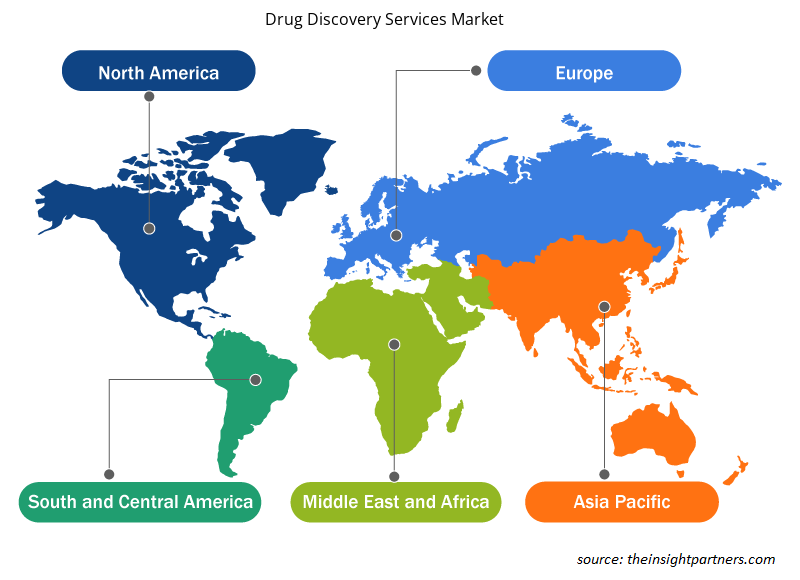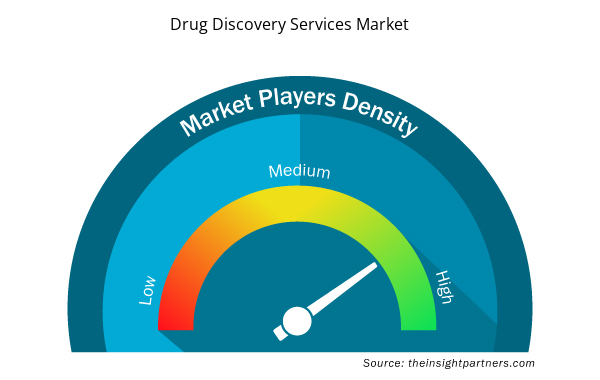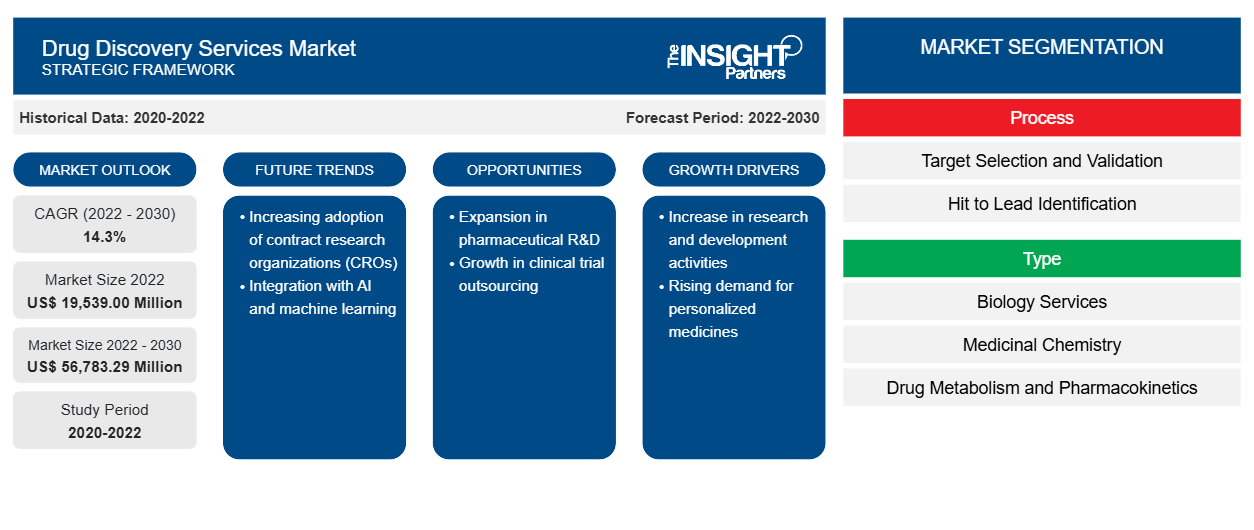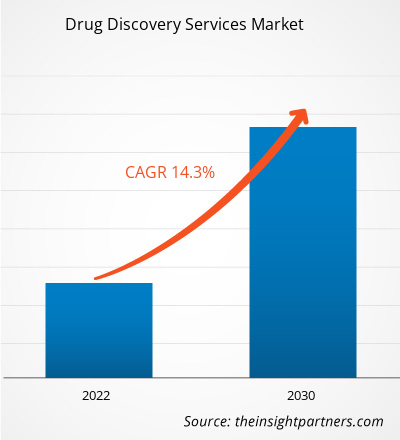[연구 보고서] 약물 발견 서비스 시장 규모는 2022년 19,539.00백만 달러에서 2030년 56,783.29백만 달러로 성장할 것으로 예상되며, 시장은 2022년에서 2030년까지 14.3%의 CAGR을 기록할 것으로 예상됩니다.
시장 통찰력 및 분석가 관점:
약물 발견은 질병을 치료하고 인간의 건강을 개선하기 위한 새로운 약물을 식별하거나 개발하는 과정입니다. 여기에는 합성에서 실험실 및 동물 모델에서의 테스트, 인간 실험에서의 평가에 이르기까지의 단계에서 잠재적인 약물 후보를 식별하는 것이 포함됩니다. 약물 발견 서비스 제공자는 약물 발견 프로세스를 지원하기 위한 전문 지식과 리소스를 제공합니다. 여기에는 의약 화학, 계산 모델링, 고처리량 스크리닝 및 전임상 테스트 서비스가 포함될 수 있습니다. 이러한 서비스는 종종 계약 연구 기관(CRO) 또는 학술 연구 기관에서 제공합니다. 제약 회사와 생명 공학 회사는 효율성을 저하시키지 않고 약물 발견 프로세스를 가속화하기 위해 이러한 서비스를 선택합니다.
성장 동인 및 과제:
약물 발견 서비스 시장은 다양한 치료 분야에서 새로운 치료법에 대한 수요가 계속 증가함에 따라 상당한 성장을 경험하고 있습니다. 약물 발견 프로세스는 복잡하고 시간이 많이 걸리며, 그 성공은 잠재적인 약물 후보에 대한 광범위한 연구와 테스트 및 검증에 기반합니다. 결과적으로 제약 회사와 연구 기관은 약물 개발 노력을 지원하는 약물 발견 서비스 제공업체에 점점 더 의존하고 있습니다. 이러한 서비스 제공업체는 다른 주목할 만한 서비스 중에서도 표적 식별 및 검증, 리드 최적화, 전임상 연구, 약동학 및 독성학 테스트를 제공합니다. 생명공학 및 제약 회사는 개별 환자의 특정 유전적 및 분자적 특성을 해결할 수 있는 표적 치료법을 개발하여 의료에 대한 보다 개인화된 접근 방식을 모색하고 있습니다. 이와 함께 정밀 의학 및 개인화된 치료법에 대한 초점이 커지면서 약물 발견 서비스에 대한 수요가 더욱 커지고 있습니다.
제약 회사의 R&D 투자 증가와 고처리량 스크리닝, 계산 모델링, 인공 지능과 같은 첨단 기술의 가용성은 약물 발견 서비스 시장에 더욱 이롭습니다. 이러한 기술은 보다 효율적이고 효과적인 약물 발견 프로세스를 가능하게 하여 새로운 약물을 시장에 출시하는 데 더 높은 성공률을 가져옵니다. 새로운 약물을 발견하고 개발하는 프로세스는 비용이 많이 들고, 종종 연구, 개발 및 임상 시험에 상당한 투자가 필요합니다. Genetic Engineering & Biotechnology 연구에서 조사한 세계 상위 20대 바이오제약 중에서 신약을 만드는 데 드는 평균 비용은 작년에 15%(2억 9,800만 달러) 증가하여 거의 23억 달러에 달했습니다.biopharmaceuticals examined in the Genetic Engineering & Biotechnology study increased by 15% ($298 million) to almost $2.3 billion last year.
임상 연구 후반 단계에서 약물 후보의 높은 실패율은 약물 개발의 전체 비용을 더욱 증가시킵니다. 결과적으로 제약 및 생명공학 회사는 점점 더 비용 효율적인 약물 발견 서비스를 찾고 있으며, 이는 서비스 제공자가 고품질 표준을 유지하면서 경쟁력 있는 가격을 제공하도록 강요합니다. 약물 분자의 높은 비용은 또한 환자의 새로운 치료법의 구매 가능성에 영향을 미치며, 특히 희귀 질환이나 틈새 치료 분야의 경우 혁신적인 치료법에 대한 접근성을 제공하는 과정에서 약물 개발자와 의료 시스템 모두에게 주요 과제 영역입니다.
귀하의 요구 사항에 맞게 이 보고서를 사용자 정의하세요
이 보고서의 일부 또는 국가 수준 분석, Excel 데이터 팩을 포함하여 모든 보고서에 대한 사용자 정의를 무료로 받을 수 있으며 신생 기업 및 대학을 위한 훌륭한 혜택과 할인 혜택을 이용할 수 있습니다.
- 이 보고서의 주요 시장 동향을 알아보세요.이 무료 샘플에는 시장 동향부터 추정 및 예측까지 다양한 데이터 분석이 포함됩니다.
보고서 세분화 및 범위:
약물 발견 서비스 시장은 프로세스, 유형, 분자 유형, 치료 영역 및 최종 사용자를 기준으로 세분화됩니다. 프로세스를 기준으로 시장은 타겟 선택 및 검증, 히트 투 리드 식별 및 기타(분석 개발, 스크리닝 등)로 세분화됩니다. 약물 발견 서비스 시장은 유형별로 생물학 서비스, 의약 화학 약물 대사 및 약동학 으로 세분화됩니다 . 분자 유형 측면에서 약물 발견 서비스 시장은 생물학 및 소분자로 분류됩니다. 치료 영역을 기준으로 시장은 심혈관 질환, 종양학, 신경학, 당뇨병, 호흡기 질환 및 기타로 구분됩니다. 최종 사용자 기준으로 약물 발견 서비스 시장은 제약 및 생명 공학 회사, 학술 기관 및 기타로 세분화됩니다. 약물 발견 서비스 시장은 지리적으로 볼 때 북미(미국, 캐나다, 멕시코), 유럽(영국, 독일, 프랑스, 이탈리아, 스페인, 기타 유럽), 아시아 태평양(중국, 일본, 인도, 한국, 호주, 기타 아시아 태평양), 중동 및 아프리카(UAE, 사우디 아라비아, 남아프리카, 기타 중동 및 아프리카), 남중부 아메리카(브라질, 아르헨티나, 기타 남중부 아메리카)로 구분됩니다.
세그먼트 분석:
소분자 세그먼트는 분자 유형을 기준으로 약물 발견 서비스 시장에서 더 큰 수익 점유율을 차지했습니다. 소분자 시장 성장은 연구하기 쉽고, 잘 정의되어 있으며, 특성화하기 쉽다는 사실에 기인합니다.
2022년, 의약 화학 분야는 유형별로 약물 발견 서비스 시장에서 가장 큰 점유율을 차지했습니다. 의약 화학은 후보 물질 전달에서 전임상 연구에 이르기까지 다양한 약물 발견 분야에서 광범위하게 사용됩니다.
치료 영역을 기준으로, 종양학 부문은 2022년 약물 발견 서비스 시장을 지배했습니다. 이 부문의 시장 성장은 전 세계적으로 암 관련 약물 발견 노력의 증가에 기인합니다. 종양학은 일반 인구에서 다양한 암의 발병률이 증가함에 따라 끊임없이 성장하는 시장입니다. 국제 암 연구 기관은 2020년에 약 1,000만 건의 암 관련 사망자와 1,930만 건의 새로운 암 사례를 추산했습니다. 전 세계 새로운 암 사례 수는 2020년에서 2040년 사이에 47% 증가할 것으로 예상됩니다. 결과적으로 2040년까지 전 세계적으로 약 2,840만 건의 새로운 암 사례가 예상됩니다.
약물 발견 서비스 시장 지역 통찰력
Insight Partners의 분석가들은 예측 기간 동안 약물 발견 서비스 시장에 영향을 미치는 지역적 추세와 요인을 철저히 설명했습니다. 이 섹션에서는 북미, 유럽, 아시아 태평양, 중동 및 아프리카, 남미 및 중미의 약물 발견 서비스 시장 세그먼트와 지리에 대해서도 설명합니다.

- 약물 발견 서비스 시장을 위한 지역별 데이터 얻기
약물 발견 서비스 시장 보고서 범위
| 보고서 속성 | 세부 |
|---|---|
| 2022년 시장 규모 | 19,539.00 백만 달러 |
| 2030년까지 시장 규모 | 56,783.29백만 달러 |
| 글로벌 CAGR (2022-2030) | 14.3% |
| 역사적 데이터 | 2020-2022 |
| 예측 기간 | 2022-2030 |
| 다루는 세그먼트 | 프로세스별로
|
| 포함된 지역 및 국가 | 북아메리카
|
| 시장 선도 기업 및 주요 회사 프로필 |
|
시장 참여자 밀도: 비즈니스 역학에 미치는 영향 이해
약물 발견 서비스 시장은 소비자 선호도의 변화, 기술 발전, 제품의 이점에 대한 인식 증가와 같은 요인으로 인해 최종 사용자 수요가 증가함에 따라 빠르게 성장하고 있습니다. 수요가 증가함에 따라 기업은 제품을 확장하고, 소비자의 요구를 충족하기 위해 혁신하고, 새로운 트렌드를 활용하여 시장 성장을 더욱 촉진하고 있습니다.
시장 참여자 밀도는 특정 시장이나 산업 내에서 운영되는 회사나 기업의 분포를 말합니다. 주어진 시장 공간에 얼마나 많은 경쟁자(시장 참여자)가 존재하는지 그 규모나 전체 시장 가치에 비해 나타냅니다.
약물 발견 서비스 시장에서 운영되는 주요 회사는 다음과 같습니다.
- 애질런트 테크놀로지스 유비퀴전트
- 애보트 연구소 주식회사
- 애드비누스 테라퓨틱스 올버니 분자 연구 주식회사
- 오리진
- 바이엘 AG
면책 조항 : 위에 나열된 회사는 어떤 특별한 순서에 따라 순위가 매겨지지 않았습니다.

- 약물 발견 서비스 시장 주요 주요 업체 개요를 알아보세요
지역 분석:
지리적으로 볼 때, 약물 발견 서비스 시장은 주로 북미, 유럽, 아시아 태평양, 중동 및 아프리카, 남미 및 중미로 구분됩니다. 북미는 글로벌 시장 성장에 가장 크게 기여합니다. 이 지역의 시장 성장은 약물 개발 회사의 투자, 미국 정부가 제공하는 대규모 보조금, 주요 약물 개발 회사의 강력한 입지, 잘 확립된 의료 인프라, 만성 질환 발병률 증가에 기인합니다.
미국 암 협회의 "암 사실 및 수치 2022"는 2022년 말까지 미국에서 약 1,918,030건의 새로운 암 사례와 609,360건의 암 관련 사망자가 발생할 것으로 추정했습니다. 이 분야의 암 발생률이 높기 때문에 향후 몇 년 동안 미국에서 암 치료제를 혁신하기 위한 연구 활동이 활발해질 가능성이 높습니다. CytoReason과 Pfizer는 2022년 9월에 다년 협력 계약을 체결했습니다. 이 계약에 따라 Pfizer는 CytoReason의 인공지능 기술을 의약품 개발에 사용할 수 있습니다. 미국의 주요 기업이 약물 발견에 AI 기술을 사용하면 약물 발견 서비스 시장이 확대될 것으로 예상됩니다.
아시아 태평양 지역은 2022~2030년 동안 약물 발견 서비스 시장에서 가장 높은 CAGR을 기록할 것으로 예상됩니다. 이 지역의 시장 성장은 중국, 인도, 일본, 한국과 같이 주요 제약 및 생명공학 허브로 부상하고 있는 국가에서 연구 개발 활동에 대한 투자가 증가하고 있기 때문입니다. 또한, 숙련된 연구원과 과학자가 많고 서구 국가에 비해 운영 비용이 낮기 때문에 아시아 태평양 지역은 약물 발견 서비스 아웃소싱을 위한 매력적인 목적지가 되었습니다. 만성 질환의 유병률이 증가하고 충족되지 않은 의료적 요구를 해결하기 위한 혁신적인 약물에 대한 필요성이 새로운 약물에 대한 수요를 창출하여 이 지역의 약물 발견 서비스 시장 성장에 도움이 되고 있습니다.
경쟁 환경 및 주요 회사:
Agilent Technologies Ubiquigent, Abbott Laboratories Inc., Advinus Therapeutics Albany Molecular Research Inc., Aurigene, Bayer AG, AstraZeneca PLC, Charles River Laboratories International, Covance, ChemBridge Corporation은 약물 발견 서비스 시장에서 활동하는 몇몇 저명한 기업입니다. 이러한 회사들은 전 세계적으로 증가하는 소비자 수요를 충족하기 위해 서비스 제공을 확대하는 데 중점을 두고 있습니다. 글로벌 입지를 통해 많은 고객에게 서비스를 제공할 수 있으며, 이를 통해 시장 점유율을 확대할 수 있습니다.
- 역사적 분석(2년), 기준 연도, CAGR을 포함한 예측(7년)
- PEST 및 SWOT 분석
- 시장 규모 가치/양 - 글로벌, 지역, 국가
- 산업 및 경쟁 환경
- Excel 데이터 세트



Report Coverage
Revenue forecast, Company Analysis, Industry landscape, Growth factors, and Trends

Segment Covered
This text is related
to segments covered.

Regional Scope
North America, Europe, Asia Pacific, Middle East & Africa, South & Central America

Country Scope
This text is related
to country scope.
자주 묻는 질문
Increasing demand for novel therapies across a wide range of therapeutic areas, and rising R&D expenditure in the pharmaceutical and biotechnology industries are driving the drug discovery services market. However, the high cost of drug discoveries hinders the drug discovery services market growth.
The drug discovery services market was valued at US$ 19,539.00 million in 2022.
Drug discovery is the process of identifying and characterizing molecules with the potential to safely modulate disease, with a goal to bring medicines that can improve the lives of patients. It is a lengthy and resource intensive process, that requires close cooperation across multiple disciplines.
The drug discovery services market has major market players, including Abbott Laboratories Inc., Agilent Technologies Ubiquigent, Albany Molecular Research Inc., Advinus Therapeutics, AstraZeneca PLC, Bayer AG, Aurigene, Charles River Laboratories International, ChemBridge Corporation, and Covance.
The drug discovery services market is expected to be valued at US$ 56,783.29 million in 2030.
Based on molecule type, the small molecules segment held the most revenue share in the worldwide drug discovery services market. Its rise was encouraged by the tiny molecules' simple, well-defined, and easy-to-characterized nature. The public is more in demand for and considerably more productive with small molecule pharmaceuticals. Because they are small molecules, they small molecules can affect cells readily and can be used to treat patients effectively. This market has grown as a result of a growing understanding of the advantages of small-molecule medications.
In 2022, the medicinal chemistry segment held the largest market share in the drug discovery services market based on type. Medicinal chemistry finds extensive use in drug discovery services, ranging from candidate delivery to preclinical studies. Consequently, this segment's prominence can be attributed to its significance. Furthermore, the biopharmaceutical businesses' increased outsourcing is anticipated to fuel this segment's expansion.
In 2022, on the basis of therapeutic area, the global market for drug discovery services was dominated by the oncology segment, owing to increase in cancer-related medication discovery efforts. The oncology market has grown as a result of the rising incidence of various cancers in the general population. The International Agency for Research on Cancer estimates that there will be about 10 million cancer-related deaths and 19.3 million new cancer cases in 2020. The global number of new cancer cases is predicted to increase by 47% between 2020 and 2040. As a result, it is projected that there will be about 28.4 million new instances of cancer worldwide in 2040.
Trends and growth analysis reports related to Life Sciences : READ MORE..
The List of Companies - Drug Discovery Services Market
- Agilent Technologies Ubiquigent
- Abbott Laboratories Inc.
- Advinus Therapeutics Albany Molecular Research Inc.
- Aurigene
- Bayer AG
- AstraZeneca PLC
- Charles River Laboratories International
- Covance
- ChemBridge Corporation
The Insight Partners performs research in 4 major stages: Data Collection & Secondary Research, Primary Research, Data Analysis and Data Triangulation & Final Review.
- Data Collection and Secondary Research:
As a market research and consulting firm operating from a decade, we have published and advised several client across the globe. First step for any study will start with an assessment of currently available data and insights from existing reports. Further, historical and current market information is collected from Investor Presentations, Annual Reports, SEC Filings, etc., and other information related to company’s performance and market positioning are gathered from Paid Databases (Factiva, Hoovers, and Reuters) and various other publications available in public domain.
Several associations trade associates, technical forums, institutes, societies and organization are accessed to gain technical as well as market related insights through their publications such as research papers, blogs and press releases related to the studies are referred to get cues about the market. Further, white papers, journals, magazines, and other news articles published in last 3 years are scrutinized and analyzed to understand the current market trends.
- Primary Research:
The primarily interview analysis comprise of data obtained from industry participants interview and answers to survey questions gathered by in-house primary team.
For primary research, interviews are conducted with industry experts/CEOs/Marketing Managers/VPs/Subject Matter Experts from both demand and supply side to get a 360-degree view of the market. The primary team conducts several interviews based on the complexity of the markets to understand the various market trends and dynamics which makes research more credible and precise.
A typical research interview fulfils the following functions:
- Provides first-hand information on the market size, market trends, growth trends, competitive landscape, and outlook
- Validates and strengthens in-house secondary research findings
- Develops the analysis team’s expertise and market understanding
Primary research involves email interactions and telephone interviews for each market, category, segment, and sub-segment across geographies. The participants who typically take part in such a process include, but are not limited to:
- Industry participants: VPs, business development managers, market intelligence managers and national sales managers
- Outside experts: Valuation experts, research analysts and key opinion leaders specializing in the electronics and semiconductor industry.
Below is the breakup of our primary respondents by company, designation, and region:

Once we receive the confirmation from primary research sources or primary respondents, we finalize the base year market estimation and forecast the data as per the macroeconomic and microeconomic factors assessed during data collection.
- Data Analysis:
Once data is validated through both secondary as well as primary respondents, we finalize the market estimations by hypothesis formulation and factor analysis at regional and country level.
- Macro-Economic Factor Analysis:
We analyse macroeconomic indicators such the gross domestic product (GDP), increase in the demand for goods and services across industries, technological advancement, regional economic growth, governmental policies, the influence of COVID-19, PEST analysis, and other aspects. This analysis aids in setting benchmarks for various nations/regions and approximating market splits. Additionally, the general trend of the aforementioned components aid in determining the market's development possibilities.
- Country Level Data:
Various factors that are especially aligned to the country are taken into account to determine the market size for a certain area and country, including the presence of vendors, such as headquarters and offices, the country's GDP, demand patterns, and industry growth. To comprehend the market dynamics for the nation, a number of growth variables, inhibitors, application areas, and current market trends are researched. The aforementioned elements aid in determining the country's overall market's growth potential.
- Company Profile:
The “Table of Contents” is formulated by listing and analyzing more than 25 - 30 companies operating in the market ecosystem across geographies. However, we profile only 10 companies as a standard practice in our syndicate reports. These 10 companies comprise leading, emerging, and regional players. Nonetheless, our analysis is not restricted to the 10 listed companies, we also analyze other companies present in the market to develop a holistic view and understand the prevailing trends. The “Company Profiles” section in the report covers key facts, business description, products & services, financial information, SWOT analysis, and key developments. The financial information presented is extracted from the annual reports and official documents of the publicly listed companies. Upon collecting the information for the sections of respective companies, we verify them via various primary sources and then compile the data in respective company profiles. The company level information helps us in deriving the base number as well as in forecasting the market size.
- Developing Base Number:
Aggregation of sales statistics (2020-2022) and macro-economic factor, and other secondary and primary research insights are utilized to arrive at base number and related market shares for 2022. The data gaps are identified in this step and relevant market data is analyzed, collected from paid primary interviews or databases. On finalizing the base year market size, forecasts are developed on the basis of macro-economic, industry and market growth factors and company level analysis.
- Data Triangulation and Final Review:
The market findings and base year market size calculations are validated from supply as well as demand side. Demand side validations are based on macro-economic factor analysis and benchmarks for respective regions and countries. In case of supply side validations, revenues of major companies are estimated (in case not available) based on industry benchmark, approximate number of employees, product portfolio, and primary interviews revenues are gathered. Further revenue from target product/service segment is assessed to avoid overshooting of market statistics. In case of heavy deviations between supply and demand side values, all thes steps are repeated to achieve synchronization.
We follow an iterative model, wherein we share our research findings with Subject Matter Experts (SME’s) and Key Opinion Leaders (KOLs) until consensus view of the market is not formulated – this model negates any drastic deviation in the opinions of experts. Only validated and universally acceptable research findings are quoted in our reports.
We have important check points that we use to validate our research findings – which we call – data triangulation, where we validate the information, we generate from secondary sources with primary interviews and then we re-validate with our internal data bases and Subject matter experts. This comprehensive model enables us to deliver high quality, reliable data in shortest possible time.


 이 보고서에 대한 무료 샘플을 받으세요
이 보고서에 대한 무료 샘플을 받으세요